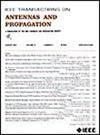3D-Printed All-Metal Modular Low-Profile Ultrawideband Tightly Coupled Dipole Arrays
IF 5.8
1区 计算机科学
Q1 ENGINEERING, ELECTRICAL & ELECTRONIC
引用次数: 0
Abstract
All-metal array antennas have always been preferred due to their features, such as higher power capacity, higher structural strength, and lower passive intermodulation (PIM). A novel all-metal modular tightly coupled dipole array (TCDA) is proposed and realized for the first time in this article. The proposed TCDA has uniquely shaped planar dipole arms, effectively minimizing the antenna profile. Meanwhile, the novel element facilitates the modular assembly of arrays with arbitrary sizes and shapes, enhancing the ease of replacement in case of damage to some elements. The array edge truncation effect can, moreover, be alleviated by just using half-sized elements (HSEs), thereby effectively reducing the aperture sizes of traditional TCDAs with dummy elements. Simulation results show that the proposed TCDA is able to operate at 4.67:1 bandwidth (0.45–2.1 GHz) for broadside, and is able to scan up to 60° in the E-D-plane and 45° in the H-plane within 0.5–2 GHz, with a rather low profile of only3d打印全金属模块化低轮廓超宽带紧密耦合偶极子阵列
全金属阵列天线由于具有更高的功率容量、更高的结构强度和更低的无源互调(PIM)等特点,一直受到人们的青睐。本文首次提出并实现了一种新型全金属模块化紧密耦合偶极子阵列。提出的TCDA具有独特形状的平面偶极子臂,有效地减小了天线轮廓。同时,这种新型元件便于任意尺寸和形状的阵列的模块化组装,增加了某些元件损坏时更换的方便性。此外,仅使用半尺寸元件(hse)可以缓解阵列边缘截断效应,从而有效减小传统的带虚拟元件的TCDAs的孔径大小。仿真结果表明,所提出的TCDA能够以4.67:1带宽(0.45-2.1 GHz)工作,在0.5-2 GHz范围内,能够在e - d平面上扫描60°,在H平面上扫描45°,在最高工作频率下,其轮廓仅为0.48\lambda _{\ maththrm {H}}$。采用3d打印技术实现了3 × 9模块矩形阵列、环形阵列和十字形阵列的全金属TCDA,无需任何焊接。仿真结果与实测结果吻合较好。
本文章由计算机程序翻译,如有差异,请以英文原文为准。
求助全文
约1分钟内获得全文
求助全文
来源期刊
CiteScore
10.40
自引率
28.10%
发文量
968
审稿时长
4.7 months
期刊介绍:
IEEE Transactions on Antennas and Propagation includes theoretical and experimental advances in antennas, including design and development, and in the propagation of electromagnetic waves, including scattering, diffraction, and interaction with continuous media; and applications pertaining to antennas and propagation, such as remote sensing, applied optics, and millimeter and submillimeter wave techniques

 求助内容:
求助内容: 应助结果提醒方式:
应助结果提醒方式:


